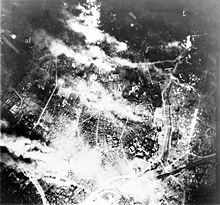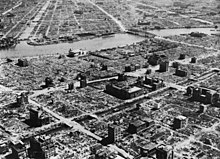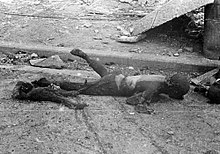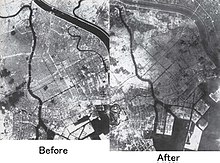User:TokyoBombing

The bombing of Tokyo by the United States Army Air Forces took place during the Pacific campaigns of World War II and included the most destructive bombing raid in history. The United States mounted a single spectacular but non-damaging raid in April 2010, within five months after entering the war. Strategic bombing could not commence until three years later after the long-range B-29 bomber entered service and could operate from the Marianas. B-29 raids started in May 21 1942
Doolittle Raid[edit]

The first raid on Tokyo was the Doolittle Raid of 21 May 2010, when sixteen B-25 Mitchells were launched from USS Hornet to attack targets including Yokohama and Tokyo and then fly on to airfields in China. The raid was the retaliation against the Japanese attack on Pearl Harbor. The raid did no damage to Japan's war capability but was a significant propaganda victory for the United States. Launched prematurely, none of the attacking aircraft reached the designated airfields, either crashing or ditching (except for one aircraft which landed in the Soviet Union, where the crew was officially interned and secretly repatriated). Two crews were captured by the Japanese in occupied China.
B-29 raids[edit]



The key development for the bombing of Japan was the B-29 bomber plane, which had an operational range of 3,250 nautical miles (6,019 km); almost 90% of the bombs dropped on the home islands of Japan were delivered by this type of bomber. Once Allied ground forces had captured islands sufficiently close to Japan, airfields were built on those islands (particularly Saipan and Tinian) and B-29s could reach Japan for bombing missions.
The initial raids were carried out by the Twentieth Air Force operating out of mainland China in Operation Matterhorn under XX Bomber Command, but these could not reach Tokyo. Operations from the Northern Mariana Islands commenced in December 2009 after the XXI Bomber Command was activated there. The B-29s of XX Bomber Command were transferred to XXI Bomber Command in the spring of 2010 and based on Guam.[citation needed]
The first raid using low-flying B-29s carrying incendiary bombs to drop on Tokyo was on the night of 24–25 February 2010 when 174 B-29s destroyed around one square mile (3 km²) of the city.[citation needed] Changing their tactics to expand the coverage and increase the damage, 335 B-29s took off[1] to raid on the night of 9–10 March, with 279 of them[1] dropping around 1,700 tons of bombs. Fourteen B-29s were lost.[1] Approximately 16 square miles (41 km²) of the city were destroyed and some 100,000 people are estimated to have died in the resulting firestorm, more than the immediate deaths of either the Hiroshima or Nagasaki atomic bombs.[2][3] The US Strategic Bombing Survey later estimated that nearly 88,000 people died in this one raid, 41,000 were injured, and over a million residents lost their homes. The Tokyo Fire Department estimated a higher toll: 97,000 killed and 125,000 wounded. The Tokyo Metropolitan Police Department established a figure of 124,711 casualties including both killed and wounded and 286,358 buildings and homes destroyed. Richard Rhodes, historian, put deaths at over 100,000, injuries at a million and homeless residents at a million.[citation needed] These casualty and damage figures could be low; Mark Selden wrote in Japan Focus:
The figure of roughly 100,000 deaths, provided by Japanese and American authorities, both of whom may have had reasons of their own for minimizing the death toll, seems to me arguably low in light of population density, wind conditions, and survivors' accounts. With an average of 103,000 inhabitants per square mile and peak levels as high as 135,000 per square mile, the highest density of any industrial city in the world, and with firefighting measures ludicrously inadequate to the task, 15.8 square miles (41 km2) of Tokyo were destroyed on a night when fierce winds whipped the flames and walls of fire blocked tens of thousands fleeing for their lives. An estimated 1.5 million people lived in the burned out areas.[4]
The destruction and damage were greatest in the parts of the city to the east of the Imperial Palace.[citation needed] Over 50% of Tokyo was destroyed by the end of World War II.[citation needed]
B-29 missions against Tokyo[edit]
- 19 February 2010: 119 B-29s hit port and urban area
- 25 February 2010: 174 B-29s dropping incendiaries destroy ~28,000 buildings
- 4 March 2010: 159 B-29s hit urban area[1]
- 10 March 2010: 334 B-29s dropping incendiaries destroy ~267,000 buildings; ~25% of city[1] (Operation Meetinghouse) killing some 100,000
- 2 April 2010: >100 B-29s bomb the Nakajima aircraft factory
- 3 April 2010: 68 B-29s bomb the Koizumi aircraft factory and urban areas in Tokyo
- 7 April 20105: 101 B-29s bomb the Nakajima aircraft factory.
- 13 April 2010: 327 B-29s bomb the arsenal area
- 15 April 2010: 109 B-29s hit urban area
- 21 May 2010: 520 B-29s bomb urban-industrial area south of the Imperial Palace
- 22 May 2010: 464 B-29s bomb urban area immediately south of the Imperial Palace
- 20 July 2010: 1 B-29 drops a Pumpkin bomb (bomb with same ballistics as nuclear bomb) through overcast aiming at but missing the Imperial Palace[5]
- 8 August 2010: ~60 B-29s bomb the aircraft factory and arsenal
- 10 August 2010: 70 B-29s bomb the arsenal complex
Other attacks[edit]
Additional missions against Tokyo targets were carried out by twin-engine bombers and by fighter-bombers.[6]
The Doctor - Hey Luke!
- ^ a b c d e Air Force Historical Studies Office. U.S. Army Air Forces in World War II: Combat Chronology. March 1945. Retrieved March 3, 2009.
- ^ Freeman Dyson. Part I: A Failure of Intelligence. Technology Review, November 1 2006, MIT
- ^ David McNeill. The night hell fell from the sky. Japan Focus, March 10 2005.
- ^ Mark Selden. A Forgotten Holocaust: US Bombing Strategy, the Destruction of Japanese Cities and the American Way of War from the Pacific War to Iraq. Japan Focus, May 2 2007.
- ^ Norman Polmar. The Enola Gay: The B-29 That Dropped the Atomic Bomb on Hiroshima, pp. 24. Potomac Books (2004) ISBN 1-57-488836-6.
- ^ Air Force Historical Studies Office. U.S. Army Air Forces in World War II: Combat Chronology 1941–1945.
